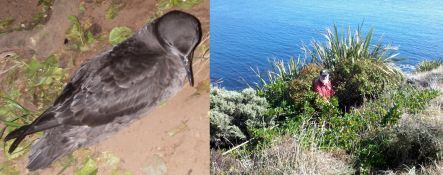
Sooty shearwaters lay their eggs in long burrows at predator-free locations on mainland New Zealand and on offshore islands. The breeding colony on Mana Island is prominently sited at the top of the island's southern cliffs, amongst grass and under a low canopy of shrubs (images: A. Ballance)
Sooty shearwaters, which are also known as titi or muttonbirds, are the most abundant bird in New Zealand, with an estimated 20 million birds. The biggest breeding populations of sooty shearwaters are on islands such as the titi islands around Stewart Island and the Snares, but a small population of just 150 or so breeding pairs on Mana Island, on Wellington's west coast, is the focus of an ongoing study by the Department of Conservation’s Graeme Taylor and Victoria University master’s student and marine conservation advocate Liz Gibson. They are putting geo-locators on birds from Mana Island to see where they feed during the breeding and non-breeding systems, and whether they travel to the same places as birds from the large southern populations, whose migrations were tracked a few years ago.
Alison Ballance joins Graeme and Liz at the sooty shearwater colony high on the southern cliffs of Mana Island for an evening vigil waiting for adult birds to arrive and feed their chicks. She finds out that during the egg incubation period sooty shearwaters from Mana Island travel as far south as the polar front or Antarctic convergence, with each adult spending 14-18 days away before they return to the colony and take over incubation duties from their partner. While they are feeding chicks the adults feed closer to the island, within a radius of a few hundred kilometres, and then during the non-breeding seasons they head up to the North Pacific to feed in a current off the east of Japan.
You can listen to Graeme Taylor working on Chatham petrels on South-East Island during the day here and at night here.
You can also listen to Colin Miskelly working on other seabird re-introduction programmes on Mana Island here.


